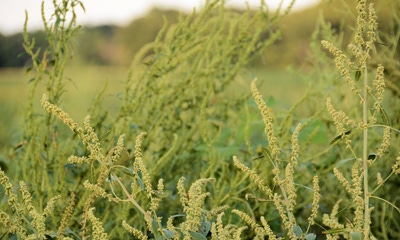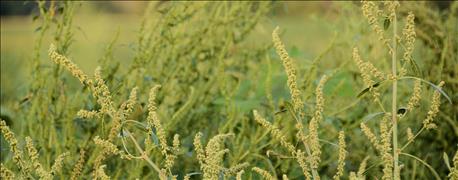
Weeds are bad. Farmers know that. But just how bad are they?
Terry Wyciskalla, an independent agronomist from Nashville, has put some numbers to that very question. In particular, he looked at waterhemp. How much water, sunlight, soil and nutrients did it rob from corn and soybean plants this year?
Wyciskalla started by collecting waterhemp samples for nutrient testing, just as if he were taking crop plant samples. He chose waterhemp because of its widespread infestation this year. He took two samples from cornfields and two from soybean fields. The fields for each crop had different soil fertility levels — one high with heavy manure, and one with average fertility.

MORE THAN UGLY: Waterhemp is robbing plants of key nutrients throughout the season. Terry Wyciskalla, Wyciskalla Consulting, Nashville, quantified the problem.
He found that waterhemp consistently contained an average of 5.2% potassium, across both crops and fertility zones.
“I was surprised, but yet I wasn’t surprised by the results,” Wyciskalla says. “No big surprise is that as soil fertility levels increased, so did waterhemp’s nutrient uptake.”
Wyciskalla also took a close look at nitrogen. In a high soil-testing cornfield, he found waterhemp contained up to 4% N. That may not sound like a big number, but Wyciskalla says to consider how many waterhemp plants could be in one field.
Then he did the math: 4% N times 1,000 pounds of waterhemp dry matter equals 40 pounds of N.
Wyciskalla estimated waterhemp dry matter at 2,000 to 3,000 pounds in some fields. One field at that level of infestation was corn. “If that was a bean field, you wouldn’t have been able to see the beans,” he explains.
“A tremendous amount of nutrients were robbed from the corn and soybean crops,” he says. “That will definitely affect crop yields.”
Wyciskalla adds that it’s difficult to calculate nutrient loss by acre because determining waterhemp dry matter in a field is challenging. Thirty waterhemp plants per square foot would be smaller plants with thinner stems. Two waterhemp plants in a square foot would be bigger, heartier plants. He recommends farmers reach out to their local agronomist for an estimate on how much waterhemp dry matter is in each field.
A precise calculation on nutrients lost in a particular field may be difficult, Wysciskalla explains, but the point of the exercise is clear: Waterhemp is locking up essential nutrients at critical points in plants' life cycles.
The nutrients are not lost forever, Wyciskalla points out, and they will cycle back into the soil over time. But for this season, plants likely failed to reach their full potential due to lost nutrients.

THE BREAKDOWN: This chart shows the nutrient analysis for the nonreplicated, random waterhemp samples taken in each field. “This analysis is a representation of what nutrients could be lost if fields contained 1,000 pounds of waterhemp dry matter,” Terry Wyciskalla explains.
About the Author(s)
You May Also Like




